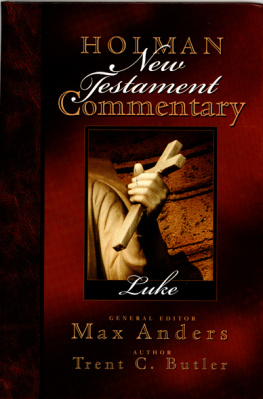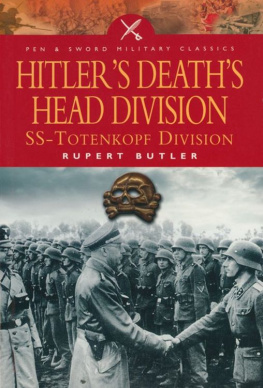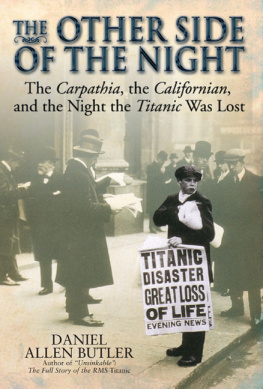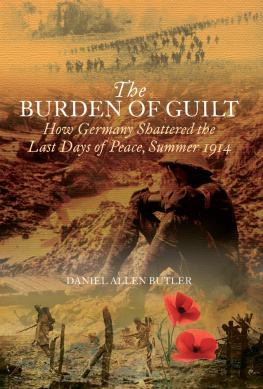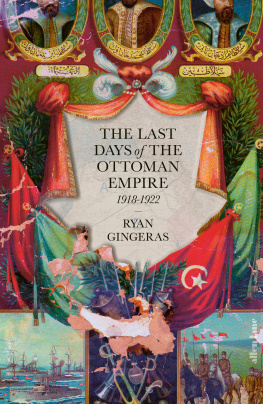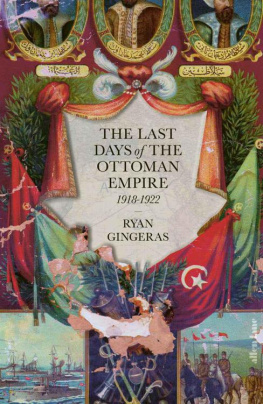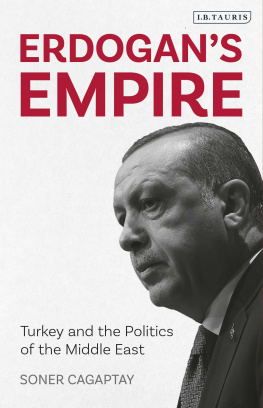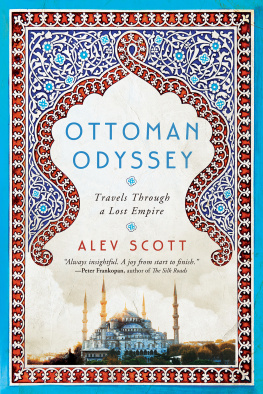Copyright 2011 by Potomac Books, Inc.
Published in the United States by Potomac Books, Inc. All rights reserved. No part of this book may be reproduced in any manner whatsoever without written permission from the publisher, except in the case of brief quotations embodied in critical articles and reviews.
Shadow of the sultans realm : the destruction of the Ottoman Empire and the creation of the modern Middle East / Daniel Allen Butler. 1st ed.
p. cm.
Includes bibliographical references and index.
Printed in the United States of America on acid-free paper that meets the American National Standards Institute Z39-48 Standard.
INTRODUCTION
It was the cataclysm that nobody knew had occurred.
Just as the world had kept its attention riveted to the four-year-long carnage of the Western Front during the Great War, so, also, it focused on the drama unfolding in the palace of Versailles as the victorious Allies dictated terms of peace to the defeated Germans. And so hardly anyone noticed that along with the Houses of Romanov, Hapsburg, and Hohenzollern, another imperial throne had vanished in the dust and rubble that were postwar Europe. It was a realm far older than any of the others, one with a history as rich, colorful, tumultuous, and bloody as any of theman empire that, at the height of its glory, had stretched from the eastern shore of the Black Sea to the Pillars of Hercules: the House of Osman and the Ottoman Empire.
And yet, in its passing, the Ottoman Empire determined much of how the next century would unfold, not only in the Middle East, but for the larger part of the civilized world as well. It was both the fortune and the curse of the Ottoman Empire and the sultans who ruled it to have been at the center of world events for most of its fourteen hundredyear history. Geography had placed the Ottoman Turks at what would become a crossroads between the Occident and the Orient at a time when those terms were still valid; history dictated that their empire would still have a place in the political and military calculus of the Great Powers even after the Ottomans power had irrecoverably waned.
Nor did the influence of the Sultans realm end with its collapse. The destruction of the Ottoman Empire would lead to the creation of one of the greatest super-powers of the twentieth centurythe Union of the Soviet Socialist Republics, and with it, a half-century of international tension that became known as the Cold War. At the same time, as the Allies dismembered the empire and created the patchwork of nation-states that became the modern Middle East, they sowed the wind that would be the whirlwind of terror and warfare reaped in the opening decade of the twenty-first century.
And because they were looking elsewhere, fascinated first by the negotiations in Versailles Hall of Mirrors, then turning their attention inward as they began to confront their own grief over the sacrifices of blood and treasure that had been made during the Great War, nobody really knew it had happened.
The Ottoman Empire would be destroyed through a combination of battles, blunders, bureaucrats, and buffoons. Campaigns such as Gallipoli, battles with names like Kut and Beersheba. Monarchs such as Sultan Abdul-Hamid and Kaiser Wilhelm II of Germany and ambitious politicians like Ismail Enver, Mehmed Talaat, David Lloyd George, and Arthur Balfour. Diplomatic ciphers like Sir Mark Sykes and Franois Georges-Picot. The empire would be brought down by men such as Gen. Sir Frederick Maude, Gen. Sir Edmund Allenby, and Lt. Col. T. E. Lawrence. And as it finally fell, the empire would introduce to the world the towering figure of Middle Eastern history in the twentieth century, Mustafa Kemal Atatrk.
While much of the narrative that follows is, of necessity, military in content, this is not a military history in the conventional sense of being a battle narrative. It is an accounting of who, how, and why, not a recapitulation of carnage and combat; it is an examination of how the Ottoman Empire essentially destroyed itself. For the Ottoman Turks did not passively stand aside while greedy and ambitious politicians in London and Paris plotted and schemed over how they would dismember the corpse of what had been called the Sick Man of Europe. That Sick Man showed a remarkable vigor in what were supposed to be his final days and, for a few brief astonishing moments, actually stood on the threshold of triumphing over the combined naval and military power of France and the British Empire. That the Turks failed in so doing was not the result of the brilliant and ruthless execution of policies by the Allies or any glorious feat of Allied arms; the Turks failed because of their own acts of commission and omission, which combined to bring down the edifice of the Ottoman Empire. In the end, it was brought down so low that all what remained, when the dust had finally settled in the Middle East, was just the shadow of the Sultans realm.

Chad Blevins
CHAPTER ONE
THE SULTANS REALM
Embedded in one of the walls of the nave of St. Stephens Cathedral in Vienna is a Turkish cannonball. A relic from the Siege of 1683, it marks the flood tide of the last great surge of the Ottoman Empire into Europe, the farthest point of the Turkish assault on Christendom. The Austrian-Polish Army, led by the Polish warrior-king Jan Sobieski, reached Vienna, with only days to spare before the beleaguered city fell, and immediately attacked the Turks. From September 11 to September 13 the two armies fought, a struggle marked by merciless ferocity and astonishing courage on both sides, before the Turks, already nearly exhausted by the siege, withdrew from Vienna, never to return. Although more than three centuries would pass before the Ottoman Empire ceased to exist, the retreat of the Ottoman Army from the walls of Vienna signaled the beginning of the empires irreversible decline and eventual collapse. Lost in the shadows of the Great War, it was a fall to which much of the world paid scant attention, yet as it died, the Ottoman Empire would give shape to the next century.
The origins of the Ottoman Turks can be traced back to the Turkic peoples who had migrated from the steppes of Central Asia to the central and eastern parts of the old Roman province of Anatolia, what is today modern Turkey, sometime between 300 and 400 A.D. In the eighth century these seminomadic tribes had given up their somewhat amorphous animistic religion in exchange for the new dynamic creed of Islam, which was then surging out of the Arabian Peninsula, its faithful bringing conversion on the edge of their swords. Called Beyliks, as early as the sixth century A.D., these settlements became small emirates nominally subject to the authority of the Seljuk Turks of Mesopotamia, their responsibility being the protection of the border that the Seljuk realm shared with the Byzantine Empire.


